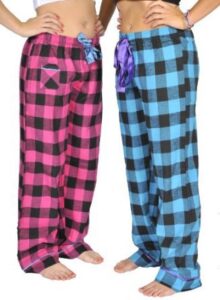
Source: http://womensflannelpajamas.net/
One of my saving graces lately has been my cotton flannel PJ pants. Whenever I’m home I can put those on, even if they do have polyester seams, and avoid contact with the lycra/spandex/elastane in yoga pants and jeans. Someday I hope to cover or change all of their polyester seams, but for now they’re the best I have, and my legs are mostly happy in them.
Naturally, knowing I have allergies to polyester, lycra/elastane/spandex, and nylon, I look for natural fibre clothing for my family as well. A few years ago, when I picked up cotton flannel PJ pants for myself, I got some for my husband as well. When I went looking for 100% cotton t-shirts, my husband also got a couple and we picked up a few for our daughter and family as Christmas gifts. My daughter looks at her clothing tags to see which clothing she can wear that makes me more comfortable when she’s sitting on my lap. Obviously if I was going to get her some PJ pants I wanted them to be cotton, preferably the same cotton flannel that the rest of her immediate family enjoys. That’s where the problems started.
 Years ago, pyjamas *were* made of natural fibres. Natural fibres breathe well, release excess sweat, and most tend to catch fire reluctantly, some being self-extinguishing. When synthetic sleepwear hit the market (quite a very long time ago now), it was known for its smooth and cool feel. What it doesn’t do well is breathe, release moisture, or protect one from flame exposure. Eventually people started to realize that synthetics don’t really burn – they melt and settle onto whatever surface gravity pulls them onto, continuing to burn that surface. Many release toxic fumes when burned or melted, many spit hot material dangerously, and many sustain a flame and continued combustion quite readily. There was a push to add flame-retardant chemicals to mattresses and furniture, and adding these chemicals to sleep wear for children wasn’t far behind. In fact, it was mandated by government. So now you have natural fibres that have been changed to synthetics, already dangerous in some circumstances, because of their flammability and the chemicals used in their manufacture. You’ve added flame-retardant chemicals to them and put them on some of our population’s most vulnerable and “protected” – children.
Years ago, pyjamas *were* made of natural fibres. Natural fibres breathe well, release excess sweat, and most tend to catch fire reluctantly, some being self-extinguishing. When synthetic sleepwear hit the market (quite a very long time ago now), it was known for its smooth and cool feel. What it doesn’t do well is breathe, release moisture, or protect one from flame exposure. Eventually people started to realize that synthetics don’t really burn – they melt and settle onto whatever surface gravity pulls them onto, continuing to burn that surface. Many release toxic fumes when burned or melted, many spit hot material dangerously, and many sustain a flame and continued combustion quite readily. There was a push to add flame-retardant chemicals to mattresses and furniture, and adding these chemicals to sleep wear for children wasn’t far behind. In fact, it was mandated by government. So now you have natural fibres that have been changed to synthetics, already dangerous in some circumstances, because of their flammability and the chemicals used in their manufacture. You’ve added flame-retardant chemicals to them and put them on some of our population’s most vulnerable and “protected” – children.
 All I wanted was a pair of cotton flannel PJ pants for my daughter. All we found were dozens of polar fleece and polyester knit PJ pants. These things would make me itch. I don’t want them on my daughter. Polar fleece is made from a form of polyester called polyethylene terephthalate, or PET (Recycling number 1). PET is a phthalate. Phthalates can often be found in nail polish, PVC, toiletries, and children’s toys. Many plastic items are now labelled phthalate-free due to concerns of endocrine disruption, hormone interference, and “reasonable expectation of carcinogenicity.” This link is also helpful. If we don’t want it in our children’s toys, why do we want it against their bodies all night, especially with added flame-retardant chemicals (which are also potentially very hazardous)? PET plastic containers are also not recommended for reuse, especially after heating, which is what we do every time we put polar fleece in the dryer. (Most of us) aren’t eating off our clothing, but the skin as an organ is a large, porous membrane, allowing all sorts of chemicals into its matrix. If we want to reduce exposures, need to stop clothing ourselves and our children in chemicals we want removed from baby toys and body care products. Polyester is no better, since it contains polyethylene glycol, to which I react, plus it still has the melting and flame-retardant chemical issue.
All I wanted was a pair of cotton flannel PJ pants for my daughter. All we found were dozens of polar fleece and polyester knit PJ pants. These things would make me itch. I don’t want them on my daughter. Polar fleece is made from a form of polyester called polyethylene terephthalate, or PET (Recycling number 1). PET is a phthalate. Phthalates can often be found in nail polish, PVC, toiletries, and children’s toys. Many plastic items are now labelled phthalate-free due to concerns of endocrine disruption, hormone interference, and “reasonable expectation of carcinogenicity.” This link is also helpful. If we don’t want it in our children’s toys, why do we want it against their bodies all night, especially with added flame-retardant chemicals (which are also potentially very hazardous)? PET plastic containers are also not recommended for reuse, especially after heating, which is what we do every time we put polar fleece in the dryer. (Most of us) aren’t eating off our clothing, but the skin as an organ is a large, porous membrane, allowing all sorts of chemicals into its matrix. If we want to reduce exposures, need to stop clothing ourselves and our children in chemicals we want removed from baby toys and body care products. Polyester is no better, since it contains polyethylene glycol, to which I react, plus it still has the melting and flame-retardant chemical issue.
 Not only is polyethylene terephthalate (PET) a phthalate, but it’s also becoming a common allergen or chemical to which people become hypersensitive. With its use in soft drink, beer, salad dressing, pickle, peanut butter, ketchup, and even toothpaste containers, not to mention in car interiors, on furniture, in hairspray, and in plastic bags, it’s everywhere around us. The most common visible reaction to PET seems to be hives, and cashiers, handling plastic bags all day, are some of the hardest hit. PET also contains (and leaches) antimony and bromine, especially if heated or reused. Antimony and bromine are a part of flame-retardant plastic blends, but are also present in containers for food use. Antimony is used in a few medical preparations, matches, bullets, paints, enamels, and has been used in the eye makeup “kohl” since ancient times. There is concern about overexposure. Bromine does have some medicinal use, but there is controversy about whether it is required for any body processes. As with anything, the right amount is key. Bromine can accumulate in the body, and continued high-level bromine exposure can lead to serious neurological, dermatological, psychiatric, and gastrointestinal function disturbances of the body.
Not only is polyethylene terephthalate (PET) a phthalate, but it’s also becoming a common allergen or chemical to which people become hypersensitive. With its use in soft drink, beer, salad dressing, pickle, peanut butter, ketchup, and even toothpaste containers, not to mention in car interiors, on furniture, in hairspray, and in plastic bags, it’s everywhere around us. The most common visible reaction to PET seems to be hives, and cashiers, handling plastic bags all day, are some of the hardest hit. PET also contains (and leaches) antimony and bromine, especially if heated or reused. Antimony and bromine are a part of flame-retardant plastic blends, but are also present in containers for food use. Antimony is used in a few medical preparations, matches, bullets, paints, enamels, and has been used in the eye makeup “kohl” since ancient times. There is concern about overexposure. Bromine does have some medicinal use, but there is controversy about whether it is required for any body processes. As with anything, the right amount is key. Bromine can accumulate in the body, and continued high-level bromine exposure can lead to serious neurological, dermatological, psychiatric, and gastrointestinal function disturbances of the body.
 I’ve since learned what I didn’t know then – due to fear of burn injuries to children, the sale of pyjamas for children is even more strictly controlled in Canada than I realized. Anything but nylon or polyester nighties are unlikely to be found at all. Cotton flannel in night- or lounge-clothes for children under 14 is also unlikely. The reason why all the cotton pyjamas I’ve seen have tight ankles and wrists is that it’s regulated by law. These regulations have indeed reduced children’s burn injuries since they were put in place, but most of these injuries were due to fireplaces and candles (open flames). For now, I will have to be content with plain cotton pyjamas, but I would hate to be trying to clothe a child with a polyester allergy for bed right now. Even those cuffs on the cotton pyjamas contain synthetics.
I’ve since learned what I didn’t know then – due to fear of burn injuries to children, the sale of pyjamas for children is even more strictly controlled in Canada than I realized. Anything but nylon or polyester nighties are unlikely to be found at all. Cotton flannel in night- or lounge-clothes for children under 14 is also unlikely. The reason why all the cotton pyjamas I’ve seen have tight ankles and wrists is that it’s regulated by law. These regulations have indeed reduced children’s burn injuries since they were put in place, but most of these injuries were due to fireplaces and candles (open flames). For now, I will have to be content with plain cotton pyjamas, but I would hate to be trying to clothe a child with a polyester allergy for bed right now. Even those cuffs on the cotton pyjamas contain synthetics.
I know I can (at least for now, and at a ridiculous price) find a pair of cotton flannel PJ pants for a child online, or make some. What saddens me is that synthetics have become so ubiquitous and accepted that we feel exposure to these chemicals is the safe choice. I suppose that in some cases it is.
